World Environment Day | World Environment Day 2021
World Environment Day
In 1972, the UN General Assembly designated 5 June as World Environment Day (WED). The first celebration, under the slogan “Only One Earth” took place in 1973. In the following years, WED has developed as a platform to raise awareness on the problems facing our environment such as air pollution, plastic pollution, illegal wildlife trade, sustainable consumption, sea-level increase, and food security, among others. Furthermore, WED helps drive change in consumption patterns and in national and international environmental policy.
In 2021, the global official celebrations will be held on 4-5 June through a Virtual Launch Gala welcoming the UN Decade on Ecosystem Restoration. The event will include inspiring messages from world leaders, activists, celebrities, and musical performances as well as Pakistan’s host country programme. To join celebrations and activities in Geneva, explore the dedicated section of this page.
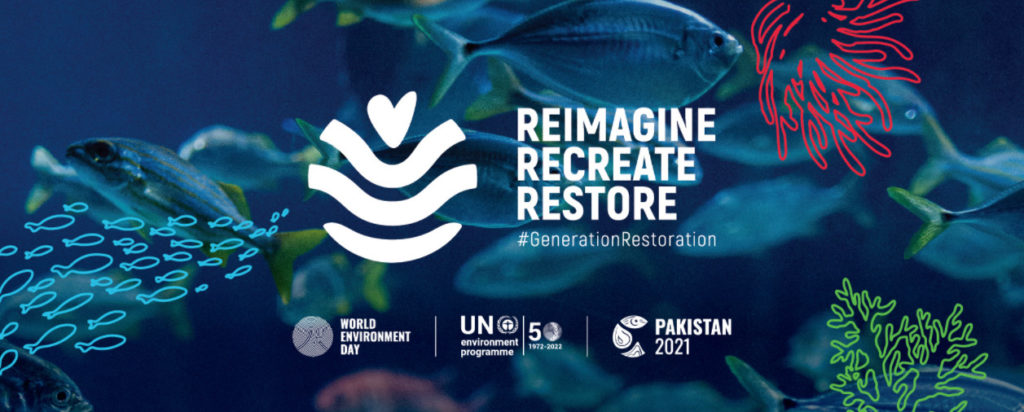
2021 Theme: Ecosystem Restoration
The theme for World Environment Day 2021 is “Ecosystem Restoration” and will see the launch of the UN Decade on Ecosystem Restoration. Ecosystem restoration can take many forms: Growing trees, greening cities, rewilding gardens, changing diets or cleaning up rivers and coasts. This is the generation that can make peace with nature.
What is Ecosystem Restoration?
Ecosystem restoration means assisting in the recovery of ecosystems that have been degraded or destroyed, as well as conserving the ecosystems that are still intact. Healthier ecosystems, with richer biodiversity, yield greater benefits such as more fertile soils, bigger yields of timber and fish, and larger stores of greenhouse gases.
Restoration can happen in many ways – for example through actively planting or by removing pressures so that nature can recover on its own. It is not always possible – or desirable – to return an ecosystem to its original state. We still need farmland and infrastructure on land that was once forest, for instance, and ecosystems, like societies, need to adapt to a changing climate.
Between now and 2030, the restoration of 350 million hectares of degraded terrestrial and aquatic ecosystems could generate US$9 trillion in ecosystem services. Restoration could also remove 13 to 26 gigatons of greenhouse gases from the atmosphere. The economic benefits of such interventions exceed nine times the cost of investment, whereas inaction is at least three times more costly than ecosystem restoration.
All kinds of ecosystems can be restored, including forests, farmlands, cities, wetlands and oceans. Restoration initiatives can be launched by almost anyone, from governments and development agencies to businesses, communities and individuals. That is because the causes of degradation are many and varied, and can have an impact at different scales.
2021 Host Country: Pakistan
Every World Environment Day is hosted by a different country, in which official celebrations take place, and this year’s host is Pakistan.
The Government of Pakistan plans to expand and restore the country’s forests through a ‘10 Billion Tree Tsunami‘ spread over five years. The campaign includes restoring mangroves and forests, as well as planting trees in urban settings, including schools, colleges, public parks and green belts.
Through the 10 Billion Tree Tsunami, Pakistan is contributing to the Bonn Challenge, a global effort linked to the UN Decade on Ecosystem Restoration. Under the challenge, countries are pledging to bring 350 million hectares of the world’s deforested and degraded land into restoration by 2030.
UN Decade on Ecosystem Restoration (2021-2030)
The United Nations General Assembly has proclaimed the UN Decade on Ecosystem Restoration following a proposal and resolution for action by over 70 countries from all latitudes. It is a rallying call for the protection and revival of ecosystems all around the world, for the benefit of people and nature. It aims to halt the degradation of ecosystems, and restore them to achieve global goals. Only with healthy ecosystems can we enhance people’s livelihoods, counteract climate change, and stop the collapse of biodiversity.
The UN Decade runs from 2021 through 2030, which is also the deadline for the Sustainable Development Goals and the timeline scientists have identified as the last chance to prevent catastrophic climate change. Led by the United Nations Environment Programme (UNEP) and the Food and Agriculture Organization of the United Nations (FAO), the UN Decade is building a strong, broad-based global movement to ramp up restoration and put the world on track for a sustainable future. That will include building political momentum for restoration as well as thousands of initiatives on the ground.
As the Decade will shape the environment for current and future generations, it is vital that young people’s perspectives and feelings about ecosystems and biodiversity are taken into account. In this sense, the UNEP Europe Office has developed a survey for youth (available in 22 languages), specifically addressed at European and Central Asian people aged 13-18 years old. It aims to find out what their knowledge and expectations are regarding ecosystem restoration in their country and region.
2021: Activities in Geneva
Events
The Geneva Environment Network will celebrate World Environment Day through a high-level event on Nature-based Solutions convened with the International Union for Conservation of Nature (IUCN) on 7 June, as well as other activities throughout the week with the participation of various stakeholders. Events by partners in Geneva are also indicated in this section.
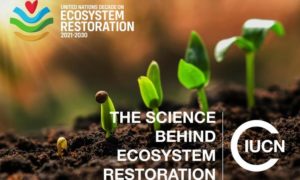
What is ecosystem restoration?: A science-based Outlook
1 June 2021 | 13:00 – 13:45 CEST | Online | IUCN
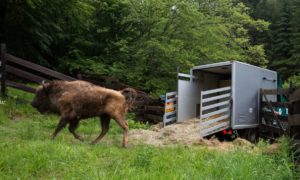
Wednesdays for the Planet | Europe Reclaims Biodiversity
2 June 2021 | 13.30 CEST | Online | Geneva Environement Network

Advancing the Climate and Environment Agendas in Fragile Contexts
3 June 2021 | 16.00 – 17.15 CEST | UN Development Programme

Innovation and Ecopreneurship for #GenerationRestoration
4 June 2021 | 17.00 CEST | WEF – 1t.org

World Environment Day at the Bioparc with Green Wheel Coffee
5 June 2021 | 9.30 – 12.00 CEST | Bioparc Geneva
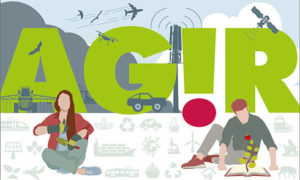
Environnement : Que fait la Genève internationale ?
5 June 2021 | 12:15 – 13:45 CEST | Muséum Geneva | Espace AG!R

EcoTrail Geneva
5 – 13 June 2021 | EcoTrail Genève
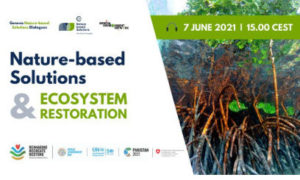
Nature-based Solutions and Ecosystems Restoration | Geneva Nature-based Solutions Dialogues
7 June 2021 | 15:00 CEST | Online | Geneva Environment Network and International Union on Conservation of Nature
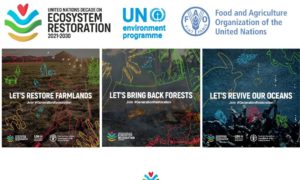
FAO Geneva Webinar Event Celebrating the launch of the UN Decade on Ecosystem Restoration 2021-2030
8 June 2021 | 12:00 | Online | FAO Geneva Office
Outdoor Activities

Birdwatching at Marais de Sionnet
Marais de Sionnet is a nature reserve located in the Geneva Canton and an ideal location to go birdwatching.

The Green Route
The Green Route brings you from Schaffhausen to Geneva in 7 routes, letting you discover six regional natural parks on your bicycle. Route 7 brings you from Le Sentier to Geneva, it is 68.9 km long.

Hike in the countryside of Geneva
From Jussy to Anières, a walking route takes you through one of the most beautiful regions in the Canton of Geneva. Along the way, discover vineyards, mountain views, the lake and, of course, biodiversity with a variety of bird species.

Hike along the Rhône
The hike from Geneva to La Plaine shows the natural beauty of the Rhône and the Moulin-de-Vert nature reserve as well as the charming villages of Cartigny and Avully.

Hike in the Allondon Nature Reserve
The hike starts in Malval and follows the entire course of the Allondon, a tributary of the Rhône and an important floodplain biotope.

Bioparc Genève
The wildlife park in Bellevue is the opportunity to discover local and exotic animal species, and learn more about conservation.
Video Programs

Genève Grandeur Nature
Monthly program on Léman Blue on Wednesdays at 20:00.
Discover the natural spaces that surrounds the Geneva area.

Museum at Home
Learn about biodiversity in Geneva from scientists of the Muséum d’histoire naturelle with their series Muséum à la maison.

Le Marronier
Cartoon series for children from the Muséum d’histoire naturelle and Terre&Nature about the animals that surround us.
Online Resources

Biodiversity in Geneva
Learn more about the different species of flora and fauna in Geneva.

Bats and COVID-19
Learn about bats and COVID-19 from the Muséum d’histoire naturelle.

InfoSpecies
Learn about the different species of flora and fauna in Switzerland.

Science Guide App
Mobile app to learn about science, biodiversity and nature activities in Switzerland.

IUCN’s Nature for All Discovery Zone
Nature-based resources to connect people with nature.
Ecosystem Restoration in Geneva
Platform “Dans ma nature”
As a result of an unprecedented collaboration between the Canton of Geneva and environmental actors in the canton, the new platform Dans ma nature aims to increase public awareness in favor of biodiversity.
Restoration Projects
The Department of Territory of the Canton of Geneva has embarked on several projects for the successful restoration of local ecosystems such as:
Drize
Hermance
Nant d’Aisy
Nant d’Avril
Nant de Braille
Plage de la Plaine
Ruisseau de Pralie
Seymaz
Versoix
Join #GenerationRestoration
Restoring ecosystems means protecting their biodiversity and helping them to deliver benefits for people and nature. It means using ecosystems on land and in the oceans in ways that strengthen their natural resources and processes. Actions for restoration can also mean preventing degradation or reducing its extent.
On World Environment Day, you can take action and join #GenerationRestoration. As outlined by the Ecosystem Restoration Playbook, there are three pathways to join the movement and improve the well-being of people and nature: taking action; making smart choices; and raising your voice for restoration.

Take Action By:
- Announcing an ambitious restoration project or policy initiative, whether at local, regional or national level – tell the world what role you will play in a ten-year push.
- Volunteering for an existing restoration effort.
- Cleaning up a lake, beach, park or other natural area
- Greening your home, business, school, or a public space with indigenous trees or plants.
- Join an ecosystem restoration camp. It is a great way to give back to the planet and make a positive impact in your local region or while travelling abroad. The camps offer a range of short to long-term volunteering programs where everyone is welcome!
Make Smart Choices By:
- Pledging a donation or other support for restoration or conservation initiatives.
- Halting purchases of products and services that are not certified as sustainable.
- Starting a new diet or catering policy based on seasonal, sustainable and plant-rich products.
Raise Your Voice By:
- Putting on or participating in an exhibition of posters, photos or art showing the beauty of local ecosystems
- Holding a discussion about the value of ecosystems and the threats they face.
- Staging an online campaign to draw attention to climate change, nature loss and what can be done to reverse these trends.
- Writing a letter to your local newspaper.
Whatever you do, celebrate the moment and spread the word! Take pictures of your World Environment Day activities and post them on social media with the tag #GenerationRestoration and #WorldEnvironmentDay to maximize your contribution to the restoration movement.
Snap Challenge
Everyone of us can take action to heal the planet. Join the #GenerationRestoration snap challenge and show us how you will make a difference.
What Restoration Can Look Like
Forests and Trees
Forests and trees provide us with clean air and water, capture vast amounts of climate-heating carbon and are home to most of Earth’s biodiversity. They supply food and fodder, fuel and materials, and support the livelihoods of billions of people.
- Plant trees: Tree planting is a simple and hugely popular restoration activity. You can add trees to a garden, a public space, a farm, across a landscape or even a whole country. Selective planting can revitalize a forest degraded by overharvesting.
- Assist natural regeneration: This low-cost restoration strategy involves creating the conditions for indigenous trees to germinate or re-sprout naturally.
- Forest landscape restoration: Well-resourced projects can secure bigger restoration gains by looking at a whole landscape.
Rivers and Lakes
Freshwater ecosystems supply food, water and energy to billions of people, protect us from droughts and floods, and provide unique habitat for many plants and animals, including one-third of all vertebrate species.
- Clean it up: Gather up all the trash and junk dumped or washed up so that people appreciate the landscape and take better care of it.
- Regulate access: Create agreed and easy-to-use access points, for instance for animals to drink, boats to land, or people to swim and relax. This will spare fragile vegetation, bird habitat and fish spawning grounds and reduce erosion at the water’s edge.
- Restore vegetation: Plant indigenous species to restore rich habitats along the banks of rivers and lakes, create wildlife corridors, and create a buffer zone between the water and sources of pollution, such as nearby industries or farms; remove invasive alien species.
- Plan sustainably: Develop fishing and harvesting plans that don’t deplete the water, fish or other resources. Reduce and treat sewage, stop chemical pollutants, industrial waste or other effluent entering the water. Strike agreements or pay incentives to reduce the use of agricultural chemicals on adjacent land.
- Protect and restore nature: On a landscape scale, seek wide agreement on the declaration of important freshwater ecosystems as protected areas. Remove dams or other infrastructure that are no longer needed and restore natural river flow. And campaign to keep residential development, dredging or mining out of sensitive areas.
Towns and Cities
Urban areas occupy less than 1 per cent of the Earth’s land surface but house more than half of its people. Despite their steel and concrete, crowds and traffic, cities and towns are still ecosystems whose condition profoundly marks the quality of our lives. Functioning urban ecosystems help clean our air and water, cool urban heat islands, shield us from hazards and provide opportunities for rest and play. They can also host a surprising amount of biodiversity.
-
Green public spaces: Design and support initiatives to restore waterways and wetlands, plant indigenous trees, and create urban woodland and other wildlife habitats along roads and railways and in public spaces. Get local businesses to help with funding and expertise. Sometimes, the best efforts come for free: Rewilding public spaces by mowing grass and cutting down plants attracts insects, birds, butterflies and even mammals to return to the city.
-
Citizens for sustainability: Campaign for sustainable urban planning, including the restoration of disused or contaminated sites, the inclusion of green spaces in new housing developments, and strong public transport networks. Faced with climate change, more citizens get involved in “adopt-a-tree” initiatives that help ensure trees – especially the young ones with shallow roots – are watered during dry spells. Digital tools, like apps, can support these efforts by tracking and coordinating individual contributions.
-
One micro-ecosystem at a time: Manage your own garden, yard, business premises or school, however big or small they are, in ways that boost nature, or care for a roadside tree. Plant indigenous species, start dense urban micro-forests and make compost.
Oceans and Coasts
Oceans and seas cover more than 70 per cent of the Earth. These ecosystems regulate our climate and generate most of the oxygen we breathe. They underpin key economic sectors, such as tourism and fisheries. And they harbor biodiversity from, whales to plankton, in habitats from sun-lit reefs to polar oceans.
- Clean up: Mobilize all ages to gather the masses of household waste and abandoned fishing gear that wash up on our beaches and shores. Recycle plastics and other materials to keep them out of landfill. Stop using avoidable and unnecessary plastic products. Watch out for microbeads and microplastics hidden in products! The more people take part, the more awareness grows of the need to reduce waste and dispose of it properly.
- Restore vegetation above and below the water: Protect and restore coastal ecosystems including saltmarshes, mangroves, coral reefs, sea-grass meadows and shellfish beds to boost their diversity and the habitats and benefits they provide. All ecosystems are complex, so get expert advice for your location.
- Use the ocean wisely: Bring together communities, authorities and other stakeholders to agree how to make coastal and ocean development and fishing sustainable, for instance by creating protected areas and deciding who can access which resources. If fishing communities come together and jointly decide on protected areas and fishing zones in their waters, people and nature benefit. Use citizen scientists to monitor the impact of degradation and the benefits of restoration.
Farmlands and Grasslands
Farmlands and grasslands are perhaps our most vital ecosystems. As well as supplying food, fodder, and fibre, arable fields and grazing land host a bewildering variety of organisms from bats and birds to beetles and worms as well as considerable tree cover. Marked by centuries of human effort and ingenuity, these ecosystems are cultural treasures whose protection makes spiritual as well as economic sense.
- Invest in nature: Reduce tillage and use natural pest control and organic fertilizer on arable land to build the health of your soil and the yields of your crops while reducing erosion and the need for farm chemicals.
- Trust in diversity: Grow more trees and a greater variety of crops and integrate them with livestock keeping to further boost soil health, diversify your income and provide better wildlife habitat. Planting flowers along the borders of farmlands can provide valuable “feeding stations” for bees and other pollinators.
- Keep grasslands whole: In extensive grasslands and savannahs, protect areas along rivers where nutrients are high from being converted to cropland. Without them, less productive areas are harder to use sustainably.
- Graze sustainably: Agree on grazing regimes that prevent overuse, soil erosion and invasions of grasslands by shrubs and alien species. Restore already degraded areas by clearing woody vegetation and re-seeding native grasses.
- Bring back indigenous species: Reintroduce eradicated plants, trees and animals and protect them from predation and hunting until they are established.
The Greener.LAND initiative has created a visual guide to techniques for restoring land and the World Overview of Conservation Approaches and Technologies has hundreds of methods to protect and restore farmlands, grasslands and other ecosystems in its Global Database on Sustainable Land Management. In addition, the PANORAMA platform brings together proven solutions for a range of ecosystems – including ideas on how to increase biodiversity in agriculture.
Mountains
Mountains harbor most of Earth’s biodiversity hotspots and supply fresh water to an estimated half of humanity. They include a multitude of ecosystems providing a home to unique species, such as snow leopards and mountain gorillas, as well as great cultural diversity among people adapted to the challenges of mountain life.
- Restore forest shields: Restore and replant forests and trees to protect soil, safeguard water flows and guard against natural disasters, such as avalanches, landslides and floods.
- Limit extraction and excavation: Our hunger for resources can have catastrophic consequences for mountains and hillsides. Make sure that landscapes are restored after mining operations have ended.
- Let ecosystems migrate: Create or connect protected areas covering different altitudes so that species and ecosystems can migrate according to the shifting climate.
- Farm for resilience: Promote and adopt sustainable farming techniques, such as agroforestry, that restore soils and biodiversity and can be more resilient in the face of climate change and extreme weather.
- Learn from experience: Tap local and indigenous knowledge to keep the use of natural resources sustainable.
This overview of how healthy ecosystems reduce disaster risks in mountainous areas is helpful and many restoration techniques in this guide can also be applied in mountain ecosystems.
Peatlands
Though they cover only 3 per cent of the world’s land, peatlands store nearly 30 per cent of its soil carbon. They control water supplies and prevent floods and droughts and provide many people with food and fuel. They also house plants and animals unique to these watery environments.
- Protect peatlands: Include these sensitive ecosystems in protected areas to prevent their drainage, conversion and overuse.
- Dam the drains: Keep peatlands healthy by closing drainage channels and slowing water flows, for example by putting rocks in ditches and streams and growing trees along their banks.
- Accelerate recovery: Plant and seed peatland plant species, such as native grasses and mosses, to boost their natural regeneration.
- Limit pressures: Outside protected areas, work with stakeholders to establish sustainable use of peatlands, for instance as extensive grazing lands. Promote alternative energy sources to reduce demand for peat as a fuel.
2010 – 2020
2020 | Time for Nature
A call to action to combat the accelerating species loss and degradation of the natural world. One million plant and animal species risk extinction, largely due to human activities. Recent events, from bushfires in Brazil, the United States and Australia to locust infestations across East Africa – and now, a global disease pandemic – demonstrate the interdependence of humans and the webs of life in which they exist. Nature is sending us a message.
2019 | Beat Air Pollution
A call for action to combat one of the greatest environmental emerging challenges of our time. Often you can’t even see it, but air pollution is everywhere and affects your health from head to toe. With every breath, you are probably sucking in tiny particles that attack your lungs, heart and brain.
2018 | Beat Plastic Pollution
The aim was for people to strive and change their everyday lives to reduce the heavy burden of plastic pollution. People should be free from the over-reliance on single-use or disposables, as they have severe environmental consequences. In addition, we should liberate our natural places, our wildlife and our own health from plastics.
2017 | Connecting Nature to People
In the city and on land, from the poles to the equator, it encourages worldwide awareness for the protection of our environment.
2016 | Go Wild for Life
The campaign aimed to reduce and prevent the illegal trade in wildlife.
2015 | Seven Billion Dreams. One Planet. Consume with Care.
This was the slogan picked through a voting process on social media.
2014 | International Year of Small Islands Developing States (SIDS)
The UN General Assembly aimed to highlight the development challenges and successes of the SIDS, focusing on global warming and its impact on ocean levels. The slogan was “Raise your voice not the sea level” for this year.
2013 | Think. Eat. Save.
The campaign addressed the huge annual food waste and loss. With the amount added together, it would release a large quantity of food as well as reduce carbon footprint. The theme also aimed to empower people to make informed choices about the food they eat so as to reduce the overall ecological impact due to the worldwide production of food.
2012 | The Green Economy
The campaign invited people to examine their activities and lifestyle and see how the concept of a “Green Economy” fits into it.
2011 | Forests: Nature at Your Service.
Activities were organized with clean-ups, concerts, exhibits, film festivals, community events, tree plantings and much more.
2010 | Many Species. One Planet. One Future.
Celebrating the diversity of life on Earth as part of the 2010 International Year of Biodiversity.

